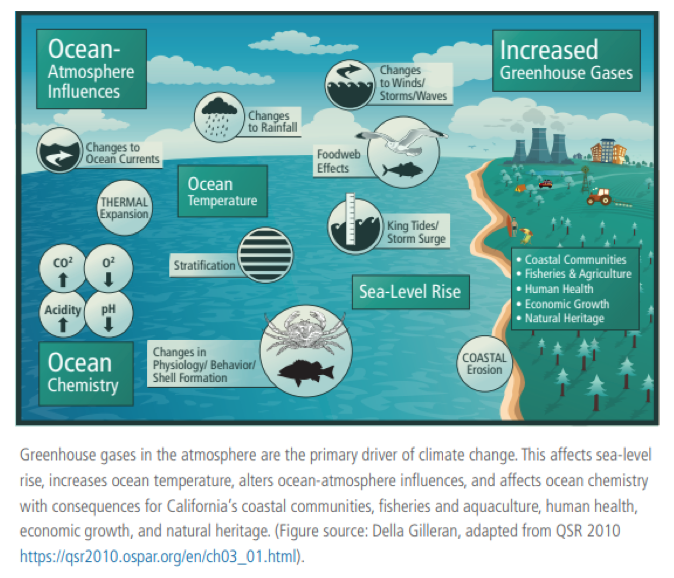California Continues to Lead on Ocean and Climate
Published by Ocean Conservancy
This week, California released its Fourth Climate Change Assessment, examining climate trends in California and how they affect the state’s citizens. Past assessments have reviewed the state of the science and the overall impact of climate change on the state, but this year’s assessment includes a novel, groundbreaking synthesis of the science about the relationship between the ocean and coast and climate change. Importantly, the assessment also focuses on how California’s communities, and particularly its most vulnerable and underrepresented, can prepare for and adapt to climate change. Simultaneously, the state legislature passed Assembly Joint Resolution 47, which “affirms [California’s] support for science-based action to conserve, protect, restore, and effectively manage California’s coastal and ocean ecosystems…in the face of challenges presented by climate change, ocean acidification, hypoxia, and other changing ocean conditions.”
As one of the advisors for the oceans chapter (Impacts of Climate Change on the Ocean and Coast), I was gratified by the focus on the ocean, which has traditionally been overlooked, both as a subject of climate change impacts and as a source of resilience against those impacts. The assessment synthesizes important, new research on the challenges we Californians face and ways we can work to address them. The timing of the assessment, coming right before Governor Brown’s Global Climate Action Summit in San Francisco in September, is ideal; oceans will be a central component of the Governor’s Summit agenda, where climate and ocean leaders from around the world will gather to take stock of how the oceans and climate communities (largely separate to date) can come together to advance solutions to some of our most pressing challenges.
Some of the most shocking findings in the assessment are around sea level rise, which is also one of the effects of climate change we are best able to understand. New science commissioned for the report shows that not only is sea level already rising—and that this rate is actually accelerating—but that without major mitigation efforts, up to 67% of Southern California beaches may erode away. That’s a big number that will put much of Southern California at-risk.
But what happens at the beach may not stay there. As beaches erode, inland communities that rely on cooler coastal temperatures may no longer have a place to escape the heat. In fact, Dr. Gary Griggs, a lead author for the Ocean and Coast chapter, highlighted at this week’s California Adaptation Forum that sea level rise “may be the biggest problem that the world and California have to face; that and water.” This is because many people in the state and the infrastructure they rely on—power plants, sewer treatment facilities, airports, and highways—are all at risk from inundation as sea level rise increases a likely 12 inches by mid-century. Furthermore, sea level rise exacerbates storm surge and king tides, even putting land that is not right on the coast (for example, the Sacramento area near the Delta) at risk. And sea-level rise induced flooding of railways, for example, may impact the movement of goods from coastal ports to destinations throughout the United States.
But sea level rise is not the only issue facing the ocean. Ocean temperatures are rising, ocean acidification is increasing, currents are shifting, and dead zones (areas of very low oxygen) are growing. As but one example, harmful algal blooms, exacerbated by climate change and a warm water “blob,” delayed the opening of the 2015-2016 Dungeness crab fishery, at a cost of more than $80 million to the state’s economy. All these effects interact with each other as well as with changes on land. California’s focus on both mitigation—stopping greenhouse gas emissions—and sustainable, equitable adaptation—being ready to deal with the changes that do occur—is more important than ever.


This type of forward-looking approach (grounded in solid science) and broadly supported by the state legislature is what Californians need more of. As Griggs said, “There’s no silver bullet right now, but someone is going to have to bite the bullet.” We Californians recognize this, and are proud to be taking bold steps to address climate change from mitigation, adaptation and resilience perspectives. This is especially important in a time of active opposition to climate action by the Trump Administration.
In three weeks, Governor Brown will celebrate climate action being taken to protect the planet—and the ocean—from the existential threat of climate change at the Global Climate Action Summit. But Californians elect a new Governor in November, and Governor Brown’s replacement will take office in January of 2019. Ocean Conservancy will look to the new Governor to carry forward Governor Brown’s climate leadership for the sake of the land, ocean and the people that call this great state home.
Sign up for our emails!
The post California Continues to Lead on Ocean and Climate appeared first on Ocean Conservancy.
Read the full article at: https://oceanconservancy.org/blog/2018/08/30/california-continues-lead-ocean-climate/


